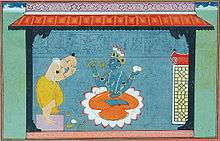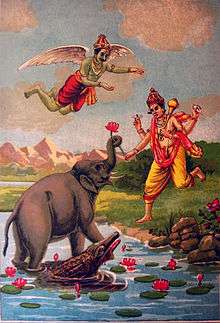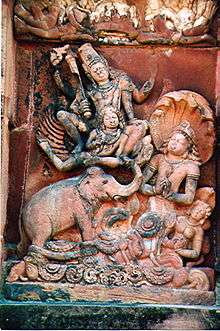Gajendra Moksha
Gajendra Moksha (Sanskrit: गजेन्द्रमोक्षः) or The Liberation of Gajendra is a Puranic legend from the 8th Skandha of the Bhāgavata Purāṇa, one of the most sacred books in Hinduism. It is one of the famous exploits of the god Vishnu. In this episode, Vishnu as avatar Hari [1] came down to earth to protect Gajendra, the elephant, from the clutches of Makara, the Crocodile, and with Vishnu's help, Gajendra achieved moksha, or liberation from cycle of birth and death. Gajendra then attained a form like that of the god (Sarupya Mukti) and went to Vaikuntha with Vishnu.
.jpg)
This story was narrated by Shuka to Emperor Parikshit at Parikshit's request.
| Part of a series on |
| Vaishnavism |
|---|
 |
|
Holy scriptures
|
|
Sampradayas
|
|
Related traditions |
|
|
Story
There was once an elephant named Gajendra who lived in a garden called Ṛtumat which was created by Varuna. This garden was located on Mount Trikuta, the "Three-Peaked Mountain." Gajendra ruled over all the other elephants in the herd. One day as usual he went to the lake near by to pick lotus flowers to offer prayer to Lord Vishnu. Suddenly, a crocodile living in the lake attacked Gajendra and caught him by the leg. Gajendra tried for a long time to escape from the crocodile's clutches. All his family members, relatives and friends gathered around to help him, but in vain. The crocodile simply would not let go. When they realised that ‘death’ had come close to Gajendra, they left him alone. He trumpeted in pain and helplessness until he was hoarse. As the struggle was seemingly endless and when he had spent his last drop of energy, Gajendra called to the god Vishnu to save him, holding a lotus up in the air as an offering.
Hearing his devotee's call and prayer, Vishnu rushed to the scene. As Gajendra sighted the god coming, he lifted a lotus with his trunk. Seeing this, Vishnu was pleased and with his Sudharshana Chakra, he decapitated the crocodile. Gajendra prostrated himself before the god. Vishnu informed Gajendra that he, in one of his previous births, had been the celebrated King Indradyumna, a devotee of Vishnu, but due to his disrespect to the great Sage Agastya, he had been cursed to be reborn as an elephant.
Because Indradyumna had been devoted to Vishnu, the god had him born as Gajendra and made him realize that there is something called Kaivalya which is beyond Svarga and Urdhva Loka, the realm of the gods. Indradyumna could attain Moksha finally when he (as Gajendra) left all his pride and doubt and totally surrendered himself to Vishnu.
The prayer made by Gajendra on this occasion became a famous hymn in praise of Vishnu called the Gajendra Stuti .
शुक्लांबरधरं विष्णुं शशि वर्णं चतुर्भुजं ।
प्रसन्न वदनं ध्यायेत सर्व विघ्नोपशान्तये॥
- śuklāṃbaradharaṃ viṣṇuṃ śaśi varṇaṃ caturbhujaṃ |
- prasanna vadanaṃ dhyāyēta sarva vighnōpaśāntayē ||
Previous Births

Gajendra, in his previous life, was Indradyumna, a great king who was devoted to Vishnu. One day, Agastya, a great rishi (sage) came to visit the king, but Indradyumna remained seated, refusing to rise up to receive the sage with due respect. Agastya was irate and noticed that the mighty king, despite the greatness of his good deeds, still had traces of Ahamkara, or egoism, and he revealed to the king that, in his next birth, he would be born as an elephant and in that form he would learn the hard way that the self must be renounced and surrendered to the Lord.
The crocodile in its previous birth had been a Gandharva king called Huhu. The sage Devala came to visit the king, and when the two of them were bathing and Devala was offering prayers to Surya (the Sun god), the king pulled the sage's leg for fun. The sage was furious and cursed the king to become a crocodile in his next life. The repentant king begged the sage's pardon. Devala explained that he could not reverse the curse; he blessed Huhu that Vishnu would slay the crocodile and liberate him from the cycle of birth and death.
Symbolic Meaning

The tale of Gajendra is an integral theme in Vaishnavism and has great symbolic value: Gajendra is the man, the crocodile is sin, and the muddy water of the lake is Saṃsāra.
The symbolic meaning of Gajendra moksha is that materialistic desires, ignorance and sins create an endless chain of karma in this world and are similar to a crocodile preying upon a helpless elephant stuck in a muddy pond. Human beings are thus stuck in a continuous cycle of death and rebirth until the day when they can look beyond everything in this creation due to some extreme experience like Gajendra when he recalls Gyana Eternal Knowledge from his previous births and an extreme experience to ultimately submit himself to the supreme being Vishnu. This relates to the concept which says without attaining real Knowledge it is impossible to get salvation but without first completely surrendering ourselves to the supreme God it is impossible to get that Eternal Knowledge that ultimately leads to salvation or Nirvana.
It is believed that this historical event took place in Sonepur, Bihar north of Patna, possibly on the banks of River Gandak a tributary of the Ganga.
Other mythological literature also indicates that the event happened in Mangalagiri, Andhra Pradesh. It is also mentioned by Sri Vallabhacharya when he took up his "tapas" for knowledge at Mangalagiri.
Shree Gajendra Moksha Stotra
The Gajendra Moksha Mantra grants the power to face difficulties and escape from them.[2]
See also
- Krishnapuram Palace, home to one of the largest murals depicting the Gajendra Moksha.
Kapisthalam, near Papanasam, Tamil Nadu is home to a temple called Gajendra Varadha Temple honouring this ancient episode. It is said that Lord Hanuman did penance here for a re-telecast of the episode and Lord Vishnu granted him a vision of the same. Hence great significance is attached to this temple for its depiction of the silver adorned lord Vishnu mounted on Garuda protecting Gajendra and offering salvation to the cursed crocodile.
References
- (ref scholars Chandan Lal Dhody, B.K Chaturvedi and Deepthi Ayyagari)
- "Gajendra Moksha". archive.org. Retrieved 30 July 2015.
External links
- Gajendra Moksha (pdf) English translation
- Bhāgavata Purāṇa: English translation of the Gajendra story
- B.K Chaturvedi: Shrimad Bhagwat Puran
- Chandan Lal Dhody: The Bhagavata
- Deepthi Ayyagari: Gajendra Moksham